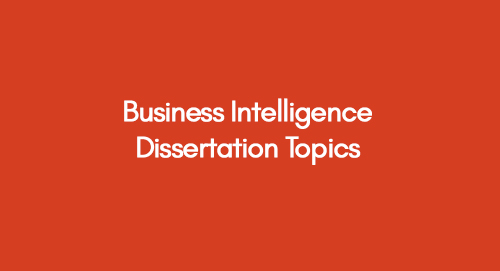
Masters Dissertation Proposal Example
March 6, 2023
Business Intelligence Dissertation Topics | List of Top Ideas With Research Aims
March 6, 2023If you are assigned to draft a proposal for an undergraduate dissertation, you may feel intimidated by the process, similar to many other students in the same situation. You might have a lot of questions about undergraduate dissertation proposals, like;
- What is a proposal?
- What is the format?
- What should be added or excluded?
- What is the requirement of a supervisor?
In this article, we will clear significant questions with the help of undergraduate dissertation proposal examples to help you ace your dissertation proposal.
In this blog post, you can review the master's dissertation proposal example and learn from expert tips on how to write a successful master dissertation’s proposal. Before we dive deeper review the master's dissertation proposal sample below:
Example: 1 Impact of Organisational Support on Employee's Psychology
Example: 2 Safety Culture in Maritime Industry
Note: Below is a complete guide with some more examples and tips for you to ace the skill of undergraduate dissertation writing.
What is an Undergraduate Dissertation Proposal?
A dissertation proposal is a roadmap of your research, and you will need to get it approved by your supervisor or dissertation committee before starting your research.
An undergraduate dissertation proposal is a plan for a research project you'll undertake as part of your studies. It outlines what you want to research, how you plan to do it, and when you aim to finish.
Essential Elements of Undergraduate Dissertation Proposal
Generally, a dissertation proposal should incorporate the following:
- A statement outlining your objectives and topic
- A survey of the literature on the status of knowledge at the moment
- An overview of the approach you recommend
- A discussion of the research's potential ramifications
- An index to pertinent sources
Dissertation proposals come in a wide range of lengths and formats, so be sure to stick to any instructions provided by your university and consult your advisor if you have any questions.
Here are undergraduate dissertation examples pdf for your consideration. You can review and download dissertation pdf samples from the following links and learn how to ace your dissertation.
- The Importance of Procurement Strategy & Impact on Construction Projects
- An Investigation of Cyberbullying and its Impact on Adolescents’ Mental Health in the UK
Is a Dissertation Proposal Necessary in an Undergraduate Program?
In many undergraduate programs, a dissertation proposal is required for the final year of study. The proposal aims to allow students to engage in independent research and demonstrate their ability to plan and execute a research project.
Submitting a dissertation proposal allows students to receive feedback from their supervisors and faculty members, which can help them refine their research questions, methodology, and expected outcomes. It also provides a structured framework for students to follow throughout the research process, ensuring they stay on track and meet their goals.
It is an important part of an undergraduate program that allows students to develop their research skills and contribute to the field of knowledge in their chosen subject.
Length of an Undergraduate Dissertation Proposal
The length of an undergraduate dissertation proposal can vary depending on the institution and the program's requirements. Typically, proposals are around 2,000 to 3,000 words in length.
Crucial Steps Before Starting a Dissertation Proposal
Before starting a dissertation proposal, it is essential to take several steps to ensure the research project is well-planned and feasible. Here are some necessary steps to consider:
- Select a Topic: Choose a research topic that interests you and is relevant to the field. It should also be manageable in terms of scope and time.
Check out How to Write a Unique Dissertation Title: Tips and Examples
- Conduct a Literature Review: Conduct a thorough review of the existing research in your field to identify gaps and areas for further investigation. It will help develop a clear research question and identify appropriate research methods.
- Consult with Supervisor: Talk to your supervisor or faculty advisor about your research topic and proposal. They can guide the project's feasibility, offer feedback on your research question and methodology, and help refine your proposal.
- Develop a Research Question: Based on the literature review and consultation with your supervisor, develop a clear and focused research question that addresses a gap or problem in your field of study.
- Determine your Research Methodology: Decide the research methodologies to answer your research question. That can include qualitative or quantitative methods or a combination of both.
- Determine your Data Collection Methods: Determine the methods you will use to collect data, such as surveys, interviews, or experiments.
- Consider Ethical Issues: Consider any ethical issues related to research, such as obtaining informed consent from participants or protecting their privacy.
- Develop a Timeline: Create a timeline for your research project, including key milestones and deadlines.
By taking these steps before starting your dissertation proposal, you can ensure that the research project is well-planned and feasible and that you are prepared to write a strong proposal.
Undergraduate Dissertation Proposal Example
Here is a step-by-step example of an undergraduate dissertation.
i. Research Aim
To determine the impacts of perceived organizational support on the psychological well-being of employees, keeping emotional intelligence as the moderating variable - the case of UK firms.
ii. Introduction
Contextual Background
In this competitive business environment, organizations have increased the company's overall efficiency and productivity by implementing various strategies and frameworks.
The study of Khan and Salahuddin (2018) identified strategies employed in an organization that increase the employees' efficiency, performance and productivity. It has been determined that employee happiness, anxiety levels, stress levels, mental wellness, emotional state and social relations are considered the best measures to analyze the psychological well-being of employees.
However, in the same context, another study studies that amongst all these factors, organizational support and emotional intelligence in the organization are considered the fundamental factor that can affect the well-being of the organization as well as the well-being of its employees (Nielsen et al., 2017).
iii. Research Gap
Several studies have studied employee well-being, and it has been identified that the well-being of employees can be related to several factors related to their family, friends and job places (Wright & Cropanzano, 2004). Another study by Van De Voorde, Paauwe and Van Veldhoven (2012) was studied that reveals that the well-being of employees may get lower if the organizations fail to provide support to their employees or understand their emotions or if there is a mismatch between the demands of the employees with their capabilities.
iv. Objectives and Research Questions
Pertaining to the information mentioned above, the following is the main research question that has been developed to conduct the study:
"How can perceived organizational support in an organization affect the psychological well-being of employees through emotional intelligence?"
This study is aimed to explore the impacts of perceived organizational support on the well-being of employees in the case of UK firms. The following objectives are established to meet this aim:
- To understand what is perceived as organizational support and what the psychological well-being of employees is
- To investigate significant factors of perceived organizational support that contribute to increasing the psychological well-being of employees
- To identify the impact of perceived organizational support on the psychological well-being of employees using emotional intelligence as the moderating variable
v. Research Contribution
This study is aimed to fill the research gap identified and to focus on the psychological well-being of employees influenced by organizational support and emotional intelligence in an organization. This study employs the findings from various studies conducted in the same notion while identifying the inconclusive results to lay the main focus of the research. Past studies have focused on the mental and physical well-being of employees. In contrast, this study is aimed to contribute by exploring the well-being of employees in terms of physical, mental, emotional/psychological aspects (Dall’Ora et al., 2016).
vi. Literature Review
Perceived Organizational Support and Psychological Well-being of Employees
Perceived organizational support is defined as the general beliefs of employees that the organization has been fulfilling the needs and demands of its employees and values for their contribution to the organization (Aselage & Eisenberger, 2003). In general, employees' psychological well-being is part of their contentment feelings when they are provided with satisfactory treatment in the organization.
vii. Research Model and Hypothesis
Following is the research model that has been developed for the research. From the figure, it has been identified that perceived organizational support is the independent variable of the study; the psychological well-being of employees is considered the independent variable, while emotional intelligence is considered the moderating variable of the study. The selection of variables has been made by reviewing the study of Caesens, Stinglhamber and Ohana (2016).
viii. Research Methods
Research Philosophy and Approach
Since this study aims to investigate the impacts of perceived organizational support on the well-being and performance of employees, the researcher intends to use the pragmatism approach to collect, arrange, organize and interpret the results that show the validity of results.
ix. Research Design
This research aimed to use the pragmatism philosophy, where the researcher has been given the liberty to select whatever the best method can be used to meet its aim, mixed research design will be used in the research. Flick (2015) identified that using mixed methodology is helpful in using both subjective and objective methods in the form of qualitative and quantitative methods to address the research questions, making it more feasible for the researcher to analyze different perspectives of the research problem.
x. Data Collection and Data Analysis
According to Mkansi and Acheampong (2012), to increase the validity of the research data and findings, primary and secondary data needs to be used in the research. Keeping this in mind, the researcher intends to use primary and secondary data collection methods to avoid misinterpreting results.
The primary data in this study will be collected from interviews, while surveys will be conducted with employees as per the quantitative data collection method. For interviews, general managers of different UK-based firms will be selected, and surveys will be conducted with employees to evaluate the perceived organizational support and their well-being.
xi. Sampling and Sample Size
The researcher will use convenience sampling under the non-probability sampling technique to select the number of interviewees and survey respondents. 250 employees will be selected from 6 UK-based firms for the survey, and the general managers of these firms will conduct ten interviews.
xii. Ethical Limitations
In order to maintain the effectiveness of the research, the researcher must maintain the anonymity of all the respondents present in the study (Bryman & Bell, 2015). For this, the researcher will ensure that no exploitation of respondents' personal information will be done in this report. Moreover, the researcher will also ensure that the content to be included in this study through secondary materials will be plagiarism-free to maintain the credibility of the research and to follow the research principles.
Conclusion
We hope the above example helps you understand the basics of undergraduate dissertation proposal writing. If you need more help, contact Premier Dissertation experts, and we will respond with a tailored solution for your writing tasks.
More on dissertation chapter writing below.
- How to Use Primary Data in Your Dissertation
- 3rd Person Writing: Why It’s Important and How to Do It
- Dissertation Acknowledgements Done Right: A Guide on How to Write Acknowledgement for Dissertation
- How to Write an Engaging Personal Statement for Your Master’s Application
- A Step-By-Step Guide on How to Write a Stellar Abstract for your Thesis
Get 3+ Free Dissertation Topics within 24 hours?


























